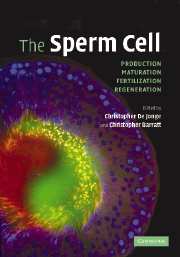Book contents
- Frontmatter
- Contents
- Preface
- List of contributors
- 1 Mammalian spermatogenesis and sperm structure: anatomical and compartmental analysis
- 2 Sperm chromatin stability and susceptibility to damage in relation to its structure
- 3 Genomic and proteomic approaches to defining sperm production and function
- 4 Sperm maturation in the human epididymis
- 5 Controls of sperm motility
- 6 Regulation of capacitation
- 7 Reactive oxygen species: friend or foe
- 8 Testing sperm manufacturing quality: the sperm–zona binding assay
- 9 Genetics: a basic science perspective
- 10 Sex chromosome abnormalities and male infertility: a clinical perspective
- 11 Epigenetic patterning in male germ cells: importance of DNA methylation to progeny outcome
- 12 The DAZ gene family and human germ cell development from embryonic stem cells
- Index
6 - Regulation of capacitation
Published online by Cambridge University Press: 14 August 2009
- Frontmatter
- Contents
- Preface
- List of contributors
- 1 Mammalian spermatogenesis and sperm structure: anatomical and compartmental analysis
- 2 Sperm chromatin stability and susceptibility to damage in relation to its structure
- 3 Genomic and proteomic approaches to defining sperm production and function
- 4 Sperm maturation in the human epididymis
- 5 Controls of sperm motility
- 6 Regulation of capacitation
- 7 Reactive oxygen species: friend or foe
- 8 Testing sperm manufacturing quality: the sperm–zona binding assay
- 9 Genetics: a basic science perspective
- 10 Sex chromosome abnormalities and male infertility: a clinical perspective
- 11 Epigenetic patterning in male germ cells: importance of DNA methylation to progeny outcome
- 12 The DAZ gene family and human germ cell development from embryonic stem cells
- Index
Summary
Introduction
Mammalian sperm are not able to fertilize eggs immediately after ejaculation. They acquire fertilization capacity after residing in the female tract for a finite period of time that varies depending on the species. In 1951, Chang (1951) and Austin (1951) independently demonstrated that such a period of time in the female tract is required for the sperm to acquire their fertilizing capacity. Both authors observed that freshly obtained rabbit sperm introduced into the Fallopian tubes shortly after ovulation were not able to penetrate the eggs; instead if sperm were introduced a few hours before ovulation, the majority of the eggs were later observed to be fertilized. This observation led them to conclude that freshly ejaculated sperm are incapable of penetrating the zona pellucida immediately, and that sperm must remain within the female tract for a period before they are able to penetrate the eggs. Following these original observations, many studies confirmed that the environment of the female tract induces a series of physiological changes in the sperm; these changes are collectively called ‘capacitation’. Inherent to these first observations was that capacitation state became defined using fertilization as end-point.
- Type
- Chapter
- Information
- The Sperm CellProduction, Maturation, Fertilization, Regeneration, pp. 134 - 169Publisher: Cambridge University PressPrint publication year: 2006
- 14
- Cited by



